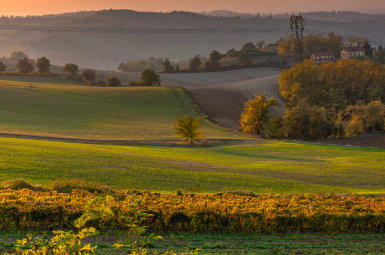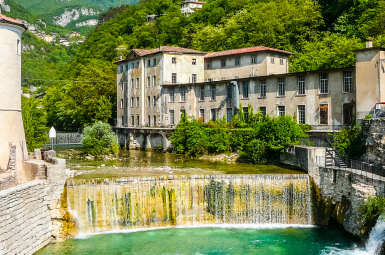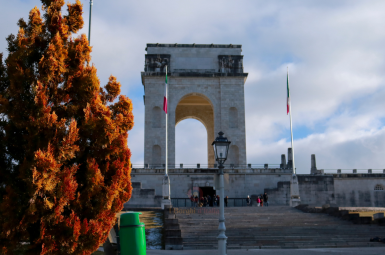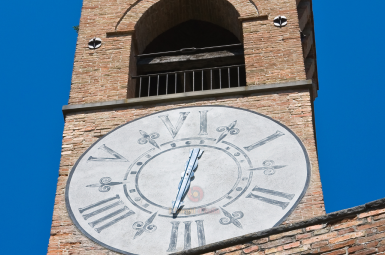
Il Borgo di Stilo
Stilo: Dove la Luce Bizantina Incontra la “Città del Sole”
Incastonata sulle pendici del Monte Consolino, Stilo non è solo un borgo, ma una straordinaria capsula del tempo che irradia la storia millenaria della Calabria Bizantina. Non per nulla è stata inclusa tra i Borghi più Belli d’Italia, incarnando un connubio perfetto tra spiritualità orientale, filosofia e paesaggi mozzafiato.La Cattolica: Il Gioiello dell’Architettura Bizantina
Il simbolo indiscusso di Stilo, e uno dei capolavori più rari del Sud Italia, è la Cattolica. Questa piccola chiesa, candidata a Patrimonio UNESCO, è un’autentica meraviglia che domina la valle dello Stilaro:- Geometria Perfetta: Risalente al X secolo, il suo nome deriva dal greco katholikì, che indicava l’edificio di culto di primo grado. La sua architettura a pianta quadrata sormontata da cinque cupole in mattoni rossi – una centrale e quattro angolari – è un esempio sublime di stile bizantino-orientale.
- Affreschi e Misteri: L’interno, sobrio ma potente, conserva tracce degli affreschi originali e presenta quattro colonne di reimpiego, una delle quali reca un’enigmatica incisione in lingua araba, suggerendo un’incredibile stratificazione culturale.
La “Città del Sole”: Stilo e Tommaso Campanella
Stilo vanta il privilegio di aver dato i natali a una delle menti più brillanti del Rinascimento italiano: il filosofo e frate domenicano Tommaso Campanella (1568-1639).- L’Utopia Calabrese: Il suo capolavoro, “La Città del Sole” (Civitas Solis), l’opera utopica che descrive una società ideale governata dalla ragione, ha conferito a Stilo il suo soprannome più affascinante.
- Memorie Visibili: Passeggiando nel borgo è possibile ripercorrere i luoghi legati alla sua vita, in particolare nei pressi della Chiesa di San Domenico, dove si trovava la sua umile cella conventuale.
Il Castello Normanno e le Grotte dei Monaci
La storia di Stilo non si limita all’arte sacra, ma si estende alle fortezze e all’eremitismo:- Sentinella di Storia: In cima al Monte Consolino, dove si giunge con un sentiero suggestivo che parte dalla Cattolica, si ergono i ruderi del Castello Normanno. Costruito da Ruggero II nell’XI secolo, offre un panorama indimenticabile che spazia fino al Mar Ionio.
- Le “Laure” Eremitiche: Il Monte Consolino è costellato di grotte naturali, note come laure, che nel Medioevo furono il rifugio di decine di monaci Basiliani (o Greco-Bizantini) in fuga dall’Oriente iconoclasta. Queste grotte, spesso con affreschi interni, rappresentano il cuore pulsante della tradizione monastica calabrese.
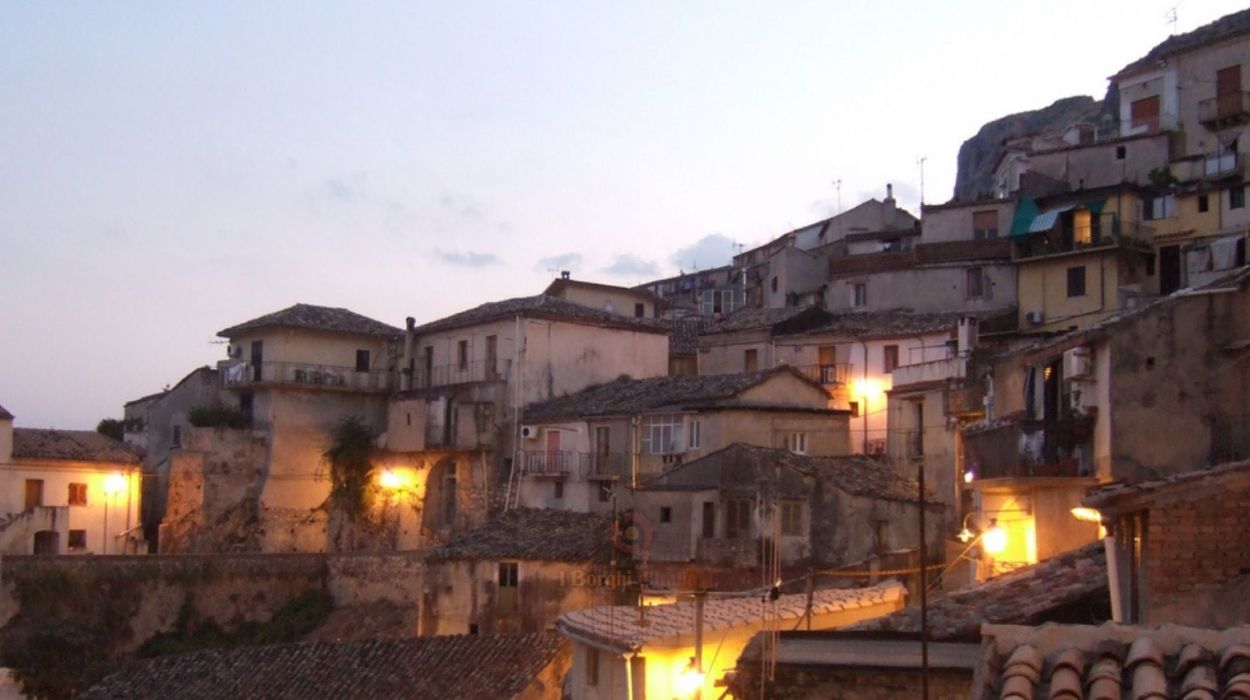
Il Borgo d’Italia
tutto da scoprire ed esplorare
Monumenti
Stilo: I Monumenti che Raccontano il Sogno Bizantino e Rinascimentale
Stilo, la “Città del Sole” idealizzata dal suo figlio più illustre, Tommaso Campanella, è un palcoscenico di storia dove le rovine normanne si fondono con l’eleganza bizantina. I suoi monumenti non sono semplici edifici, ma pagine scolpite di un passato in cui monaci, filosofi e guerrieri hanno lasciato un’eredità inestimabile, proiettando il visitatore in un viaggio epico attraverso il Medioevo calabrese.
1. La Cattolica: Il Vertice dell’Architettura Bizantina
La Cattolica di Stilo è, senza dubbio, il monumento più iconico della città e il più alto esempio di architettura bizantina in Calabria. Arroccata alle pendici del Monte Consolino, è una meraviglia di armonia e proporzioni.
- Il Nome e la Struttura: Il termine Cattolica deriva dal greco katholikì, indicando l’edificio di culto di riferimento. Risalente al X secolo, presenta una rara pianta quadrata (a croce greca inscritta) sormontata da cinque cupole disposte a quinconce, un tratto distintivo delle chiese orientali.
- L’Interno: L’interno, sobrio ma potente, conserva ancora resti di affreschi originali e colonne di spoglio (riutilizzate da edifici precedenti), tra cui spicca una che reca un’iscrizione in arabo, testimonianza di un incredibile crocevia culturale.
2. Il Castello Normanno: La Fortezza Sulla Rupe
In posizione dominante, a vegliare sul borgo e sull’intera Valle dello Stilaro, si erge il Castello Normanno .
- Edificazione e Storia: Costruito probabilmente nell’XI secolo per volere di Ruggero II il Normanno, il castello era il fulcro della difesa militare del Regio Demanio (il demanio regio). Nonostante oggi sia in rovina a causa dei secoli e delle distruzioni belliche, le sue mura perimetrali e le torri offrono un belvedere strategico e maestoso.
- Accesso Panoramico: È raggiungibile dalla Cattolica tramite un suggestivo sentiero in salita che regala panorami mozzafiato sulla costa e sui monti.
3. Il Duomo (Chiesa Matrice): Dal Pagano al Barocco
Il Duomo di Stilo (Concattedrale di Santa Marina Assunta) rappresenta la stratificazione storica del borgo, evolvendosi attraverso i secoli.
- Fusione di Stili: Eretto nel XIII-XIV secolo in stile gotico-normanno su fondamenta che si ipotizzano essere un antico mausoleo pagano, ha subito pesanti rifacimenti, in particolare dopo il devastante terremoto del 1783, assumendo l’aspetto barocco che in gran parte conserva oggi.
- Opere d’Arte: Al suo interno, si possono ammirare opere importanti, tra cui una monumentale pala d’altare del pittore napoletano Giovan Battista Caracciolo, detto il Battistello.
4. L’Abbazia di San Giovanni Theristis: Il Monachesimo Greco
A poca distanza dal centro, nella valle sottostante, si trova l’imponente complesso dell’Abbazia di San Giovanni Theristis .
- Il Santo Mietitore: L’abbazia è dedicata a San Giovanni Theristis, il “Santo Mietitore”, un monaco basiliano che visse in quest’area tra il X e l’XI secolo.
- Architettura e Reliquie: La chiesa abbaziale, ricostruita in stile barocco dopo il terremoto del 1783, ma con tracce visibili della struttura originaria (in particolare una magnifica cupola), custodisce al suo interno le reliquie del santo in un’arca marmorea, testimoniando l’importanza del monachesimo orientale nella “Valle Bizantina dello Stilaro”.
Altri Monumenti e Simboli
- Le “Laure” Eremitiche: Le grotte sul Monte Consolino (le laure) sono monumenti di spiritualità, antiche dimore dei monaci basiliani che scelsero la roccia come luogo di ascesi e preghiera.
- Porta Stefanina: Una delle cinque antiche porte d’accesso al borgo, ancora ben conservata, che testimonia la cinta muraria medievale di Stilo.
- Fontana dei Delfini (Gebbia): Una fontana rinascimentale con un chiaro influsso arabeggiante, simbolo dell’importanza e della ricchezza civica del borgo.
Curiosità
Stilo: I Segreti di un Borgo dove la Filosofia Incontra il Sacro Bizantino
Stilo non è solo un borgo, è un enigma incastonato nella roccia, un luogo dove la storia ha lasciato tracce tanto straordinarie quanto inaspettate. Dalla carta d’identità nazionale alle utopie filosofiche, ecco le curiosità che rendono questa “Città del Sole” un tesoro calabrese ineguagliabile.
1. Il Passaporto Italiano Nasconde la Cattolica
Pochi sanno che il monumento simbolo di Stilo ha un posto d’onore nel documento di viaggio per eccellenza: il Passaporto Italiano.
- Icona Nazionale: L’immagine stilizzata della Cattolica, con le sue inconfondibili cinque cupole bizantine, è impressa sulla filigrana di una delle pagine del nostro passaporto, inserendosi tra i grandi simboli artistici e storici del Paese come Castel del Monte e il Pantheon.
- Motivo d’Orgoglio: Un riconoscimento silenzioso ma potente che eleva questo capolavoro del X secolo a icona rappresentativa dell’identità culturale italiana, in particolare per la sua unicità come testimonianza dell’architettura bizantina.
2. Stilo: La Vera “Città del Sole”
Il borgo è indissolubilmente legato alla figura del filosofo Tommaso Campanella, nato proprio qui nel 1568.
- Il Sogno Utopico: Campanella, frate domenicano e pensatore dirompente, ambientò il suo celebre trattato filosofico e utopico, “La Città del Sole” (Civitas Solis), in una società ideale governata dalla ragione e dalla scienza. Sebbene la sua utopia fosse immaginaria, il soprannome è rimasto al suo paese natale, rendendo Stilo il luogo dove il sogno della ragione prese forma.
- La Cella Scomparsa: È possibile visitare i luoghi legati al suo passaggio, in particolare l’area dell’ex Convento di San Domenico, dove si trovava la sua umile cella e dove maturò gran parte del suo pensiero, prima delle sue travagliate vicende giudiziarie.
3. L’Iscrizione Arabeggiante nella Chiesa Bizantina
All’interno della Cattolica, si cela una delle curiosità più affascinanti che testimoniano i complessi intrecci culturali della Calabria medievale.
- La Colonna Enigmatica: Una delle quattro colonne che sorreggono la struttura interna presenta una singolare iscrizione in lingua araba. Si ipotizza che questa colonna provenga da un edificio preesistente, forse un antico tempio o addirittura una moschea in seguito a una breve dominazione, dimostrando come a Stilo l’influenza orientale e l’interazione tra culture fossero una realtà tangibile.
- Simboli Templari: Sempre all’interno, su una colonna a destra dell’ingresso, alcuni studiosi hanno interpretato una croce con lettere greche come un possibile riferimento ai Cavalieri Templari, aggiungendo un ulteriore velo di mistero alla storia del luogo.
4. Palio di Ribusa: Rivivere il Rinascimento Calabrese
Ogni anno, Stilo non si limita a ricordare il suo passato, ma lo riporta in vita con una delle rievocazioni storiche più autentiche del Sud Italia.
- La Fiera Medievale: Il Palio di Ribusa, che si svolge la prima domenica di agosto, non è solo una gara cavalleresca, ma la rievocazione dell’antica “Fiera di Ribusa”, documentata già nel 1600.
- Immersione Totale: Per alcuni giorni, il borgo si trasforma in un teatro a cielo aperto: giocolieri, menestrelli e artigiani animano un mercato storico, dove è possibile persino acquistare con il Ribuso, l’antica moneta coniata per l’occasione, offrendo un’esperienza immersiva nel Rinascimento calabrese.
Personaggi
Le Figure Eminenti di Stilo: Geni, Santi e Visionari Nativi della Città del Sole
Stilo, la gemma bizantina incastonata tra i monti calabresi, ha dato i natali a personalità la cui influenza ha travalicato i confini della regione e del tempo, lasciando un segno indelebile nella storia della filosofia, della religione e della cultura. La sua terra aspra e spirituale ha forgiato menti brillanti e anime dedite, rendendo il borgo non solo un sito monumentale, ma un vero e proprio focolare di ingegno.
1. Fra’ Tommaso Campanella: Il Filosofo dell’Utopia
Il nome di Stilo risuona in tutto il mondo grazie al suo figlio più illustre: Giovanni Domenico Campanella, universalmente noto come Fra’ Tommaso Campanella (Stilo, 1568 – Parigi, 1639).
- Il Genio Riformatore: Campanella fu un filosofo, teologo e poeta di immensa levatura, il cui pensiero fu rivoluzionario per l’epoca. Entrato nell’ordine domenicano da giovanissimo, divenne un fervente critico dell’aristotelismo tradizionale e uno strenuo sostenitore della filosofia della natura di Bernardino Telesio.
- La Città del Sole: La sua opera più celebre, “La Città del Sole” (Civitas Solis), è un trattato utopico scritto durante i suoi lunghi anni di prigionia a Napoli (fu perseguitato dall’Inquisizione e dalla Spagna per le sue idee libertarie e per una congiura antispagnola). L’opera descrive una repubblica ideale basata su scienza, ragione e comunione, un sogno di società perfetta che idealmente si collega al suo luogo d’origine.
- Eredità Globale: La sua figura incarna la tensione della Calabria tra repressione politica e desiderio insopprimibile di libertà intellettuale, rendendolo un pensatore di rilevanza europea.
2. San Giovanni Theristis: Il Santo Mietitore
Nella spiritualità di Stilo, una figura di spicco è San Giovanni Theristis (San Giovanni il Mietitore), un esempio emblematico del monachesimo greco-bizantino che fiorì nella Valle dello Stilaro.
- La Vita Eremitica: Nato a Stilo o nelle immediate vicinanze nel X secolo, Theristis visse una vita di ascesi e contemplazione. La leggenda vuole che si fosse dedicato alla preghiera e al lavoro nei campi, guadagnandosi il soprannome di “Mietitore” grazie a un miracolo legato alla mietitura del grano.
- Il Legame con l’Abbazia: Le sue reliquie sono conservate nell’omonima Abbazia di San Giovanni Theristis (anche se l’attuale edificio è stato ricostruito in stile barocco), che per secoli fu uno dei più importanti centri di culto e cultura basiliana (di rito greco-ortodosso) in Calabria, riaffermando l’identità profondamente orientale di Stilo.
3. Luigi Cunsolo: Lo Scrittore e Poeta
Più vicino ai tempi moderni, Stilo ha celebrato l’intelletto di Luigi Cunsolo (Stilo, 1904 – 1972), una figura di spicco nel panorama letterario e culturale calabrese.
- Voce della Calabria: Cunsolo fu un apprezzato scrittore, poeta e traduttore, la cui opera si dedicò spesso a celebrare e descrivere con passione e rigore la sua terra.
- Un Impegno per la Cultura: La sua attività non fu solo letteraria, ma anche di forte impegno civico nella promozione della cultura e della storia calabrese, lasciando un’eredità che contribuisce tuttora alla riscoperta dell’identità stilita.
Questi illustri nativi, ognuno a suo modo – con la profondità filosofica di Campanella, la santità di Theristis e la voce letteraria di Cunsolo – hanno trasformato la storia di Stilo da mero accadimento locale a patrimonio dell’umanità.
Ricette Tipiche
Stilo in Tavola: L’Anima della Calabria Tra Sapori Genuini e Tradizione Bizantina
La cucina di Stilo e dell’intera Valle dello Stilaro è un inno alla semplicità e alla ricchezza del territorio. Dalle erbe selvatiche che fioriscono alle pendici del Monte Consolino, agli inconfondibili sapori della Locride, ogni ricetta è un racconto di vita contadina, monastica e marinara. Dimenticate le sofisticazioni: qui, la vera arte è trasformare ingredienti poveri in capolavori di gusto.
1. Il Re della Tavola: I Primi Piatti Terrigni
A Stilo, la pasta non è solo un alimento, ma il centro della convivialità, quasi sempre fatta a mano e condita con i sapori più veraci.
A. I “Fileja” con Ragù di Capra o Salsiccia
I Fileja (o filateddhi) sono la pasta fresca per eccellenza della Calabria centrale e meridionale.
- Lavorazione Artigianale: Si presentano come dei cordoncini attorcigliati intorno a un ferro da calza (il ferretto), creando una forma elicoidale perfetta per catturare il condimento.
- Condimento Robusto: Tradizionalmente a Stilo e dintorni vengono esaltati da sughi lunghi e potenti. Il classico è il ragù di capra o, in alternativa, il saporito ragù di maiale arricchito da pezzi di salsiccia locale (spesso piccante), un omaggio alla tradizione norcina calabrese.
B. Lagane e Cicciari (Pasta e Ceci)
Un piatto umile ma essenziale, retaggio della cucina monastica e contadina, dove i legumi sono i veri protagonisti.
- Le Lagane: Sono una pasta corta e larga, simile a tagliatelle rustiche ma senza uovo, il cui nome deriva dall’antico termine greco laganon.
- Il Condimento: Vengono servite con i ceci (cicciari), insaporite con aglio, alloro e un generoso filo di Olio Extra Vergine d’Oliva della Locride (anch’esso prodotto nella zona di Stilo), in un equilibrio perfetto tra terra e semplicità.
2. Il “Sapore di Mare e Montagna”: Secondi e Contorni
Nonostante Stilo sia un borgo di montagna, la vicinanza al Mar Ionio ha plasmato una cucina che non rinuncia né alla carne né al pesce.
A. Stocco alla Mammolese (o alla Stilita)
Lo Stoccafisso (merluzzo essiccato, da non confondere con il baccalà sotto sale) è incredibilmente popolare nella cucina calabrese, soprattutto nell’area limitrofa di Mammola e, di riflesso, a Stilo.
- La Preparazione: Il merluzzo viene ammollato a lungo e poi cucinato in un ricco stufato con prodotti dell’orto: pomodoro, cipolla (spesso quella rossa di Tropea), patate tagliate a pezzi grossolani, olive nere e, immancabile, il peperoncino (diavulillu).
- Contrasto Storico: Questo piatto, apparentemente strano in un contesto meridionale, è una testimonianza dei lontani traffici marittimi tra il Mediterraneo e la Norvegia.
B. I Pipi e Patate (Peperoni e Patate)
Il contorno più tipico e irrinunciabile che spesso si trasforma in un piatto unico.
- Essenza Estiva: Peperoni (gialli e rossi) e patate vengono tagliati a pezzi e cucinati in padella, amalgamandosi con olio d’oliva e basilico.
- Variante Arricchita: In alcune versioni, vengono aggiunti dei tocchetti di salsiccia secca o dei peperoni “cruschi” (peperoni essiccati e fritti velocemente) per donare croccantezza e un sapore più intenso.
3. La Dolcezza e i Prodotti Locali
La tradizione dolciaria, legata alle feste religiose, è robusta, ma l’eccellenza di Stilo si trova anche nei prodotti che definiscono il suo paesaggio.
A. Il Vino Bivongi DOC
Sebbene Stilo non produca vino direttamente, essa è parte integrante della zona di produzione del Bivongi DOC, un vino locale di pregio.
- Carattere del Territorio: Un vino, nelle sue versioni Rosso (con predominanza di Gaglioppo e Greco Nero) e Bianco, che accompagna perfettamente la robustezza dei sapori locali ed è un eccellente ambasciatore della Valle dello Stilaro.
B. Dolci di Pasqua e Feste
Durante le feste, in particolare la Pasqua, è consuetudine preparare dolci secchi e lievitati:
- La Cuzzupa: Dolce pasquale per eccellenza, un impasto morbido di farina, uova e zucchero, spesso decorato con uova sode e zuccherini colorati, simbolo di buon augurio.
- Le Nepitelle: Dolcetti ripieni di un composto ricco a base di fichi, noci, mandorle, cacao e talvolta miele, perfetti per concludere un pasto sontuoso.
